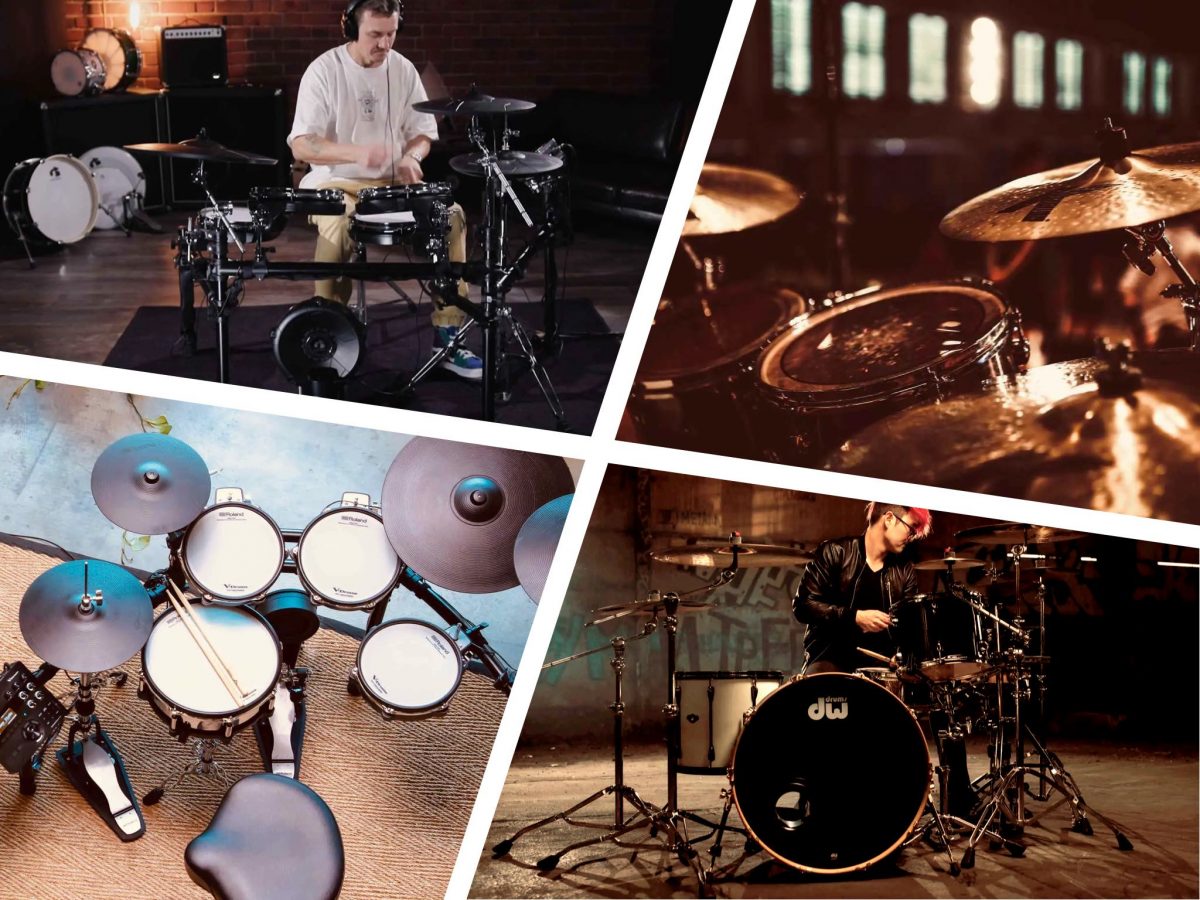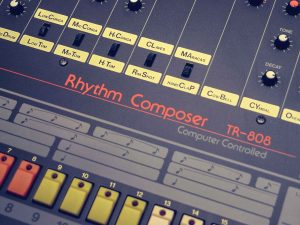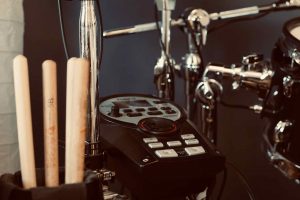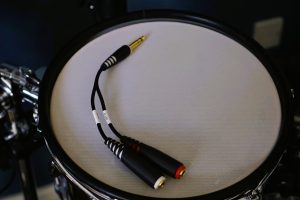Electronic drums and acoustic drums are good for different situations. Below, we take a look at acoustic vs electronic drums for beginners, who are likely to ask this question as they begin their drumming journey and only have the budget for one kit. Read on for all the main pros and cons and where there’s a clear winner on each point.
Pros and cons
| Acoustic drums | Electronic drums |
| Acoustic drums are very loud | Electronic drums are much quieter |
| The “real” playing experience – drums respond exactly as you play them | Even the best electronic drums can’t replicate the playing feel of an acoustic kit exactly |
| Drum tuning is an art and can be difficult for beginners | Electronic drums don’t need to be tuned |
| No tuition features | Built in metronome and song play-alongs |
| Cheap acoustic drums are full-size and play almost as well as high-end ones, even if they don’t sound great | Cheap electronic drums use small pads and feel dramatically worse to play than mid/high-end eDrums |
Noise
As you’d expect, electronic drums are far quieter than acoustic drums, which is why electronic drums are good practice tools for at home where an acoustic kit might not be appropriate. According to Roland, electronic drums can be as low as 60-75 decibels, which is equivalent to a car driving down a road, while acoustic drums are from 90 to 120 decibels, which is as loud as a jet engine.
In practical terms, the high volume of acoustic drums – even when played gently – means you need to limit the amount you play. Even playing gently at 90 db can cause hearing damage after 50 minutes, while 110 db can only be safely sustained for 5 minutes. 120 db is immediately unsafe and can cause pain and hearing damage.
Because of this, it’s essential that you wear hearing protection when playing acoustic drums, even for short periods of time.
Meanwhile, because electronic drums are much quieter, they are less of a nuisance for others, and can be played for longer provided the volume is set at a reasonable level – especially if you play your eDrums through headphones.
Winner: Electronic drums as they are much quieter and therefore more feasible to play in more situations like practising at home
Do electronic drums sound like real drums?
Electronic drums sound like real drums to varying degrees, depending on the type of drum module being used and how those drum sounds were originally recorded or generated. In general, cheap electronic drums don’t sound very much like real drums, while mid to high-end electronic drums sound almost indistinguishable from real drums.
The best electronic drums sound just like recorded acoustic drums because in effect, that’s what they are. High end drum modules like the Pearl Mimic Pro actually use ‘sampled’ drum sounds, made by recording a real drum in a studio being hit multiple times. Those recordings are then ‘triggered’ by your drum pad and played back. This technology can also be used on cheap electronic drums by connecting the drum kit to a computer running VST software. This is a great way to make a cheap electronic drum kit sound more realistic.
Another factor that impacts the way that electronic drums sound is how ‘produced’ the drum sounds are. Some drum modules sound very ‘produced’ or ‘polished’, such as those in the Roland V-Drum range, while other manufacturers like ATV tend to use more natural sounding drum samples.
The reason for this is that drum samples on modules often have various EQ, compression, and ambient effects applied. These effects make the drums have more in common with those on commercial recordings than a real drum kit in a room. However, they can sound unnatural to some drummers, as these ‘mixed’ sounds are designed to make the drums stand out over a backing track, rather than being played solo. When I see drummers complain on forums about unrealistic eDrum sounds, it’s usually these effects they’re referring to.
A solution is to choose a module that uses natural or unmixed drum sounds, or use a VST like Superior Drummer which gives you complete control over the mix of your drum sounds. Often, I use Superior Drummer with no EQ or compression altogether – just the raw drum recordings and ambient mics – giving a very natural sound like a real drum kit.
Of course, the one thing missing from an electronic kit is ‘presence’ of an acoustic kit. By its very nature, an acoustic kit is moving air when played and creating vibrations which can be felt by the player. Some drummers love this physical feedback which doesn’t exist on electronic kits by virtue of not being an acoustic instrument.
This can be simulated on electronic drums by using a ButtKicker, which sends vibrations through your drum throne in response to your drumming. Of course, the downside here is this technology is not great for soundproofing your drums if you live in an apartment.
Winner: Acoustic Drums, though the best modern eDrums and drum VST software allow eDrums to sound almost indistinguishable from acoustic drum recordings.
Playing feel
Electronic drums don’t feel exactly like acoustic drums when it comes to playing feel, but the best ones get very close. Most mid to high-end eDrums use mesh drum pads, which feel slightly more bouncy than a real acoustic drum. You can offset this effect by using lighter drumsticks.
Typically, cymbal pads have a rubber coating which absorbs some of the rebound that you’d get from an acoustic cymbal. However, some smaller-scale manufacturers offer metal eCymbals. These are muted to reduce the volume but are usually still a little louder than rubber cymbal pads.
There are also other factors that affect playing feel, such as the diameter of eDrums usually being smaller than acoustic drums. Learn more about how electronic drums feel in our guide.
Winner: Acoustic drums have to win here as the ‘authentic’ drumming experience. If you want an electronic drum kit, buy one with mesh heads for the most realistic playing experience.
Tuition & learning features
A key benefit of electronic drums over acoustic drums is the inclusion of various tuition features. These include the following:
- Built-in metronome
- Ability to play along to songs, backing tracks or loops via the module’s song player
- Ability to play along to a device via bluetooth, USB interface or Aux input
- Inclusion of coaching software with some eDrum kits
- Ability to record your performance simply and easily via USB interface or master output
None of the above features are included with acoustic drums for obvious reasons – they have no processing module. Instead, you’d need to buy a standalone metronome, use a pair of isolating headphones, or even a set of drum microphones and an audio interface if you want to record your performance at the same level of quality.
Find out more about if it’s better to learn electronic or acoustic drums in our guide.
Winner: Electronic drums due to the inclusion of a range of tuition tools
Tuning & maintenance
A great benefit of electronic drums is the fact that they don’t need to be tuned – the drum sounds are already ‘tuned’ out of the box.
Meanwhile, tuning an acoustic drum kit can be very difficult for beginners and has a steep learning curve. Personally, it took me many years to feel confident with tuning drums. External factors like room acoustics have a big impact on how a drum sounds, which can be very confusing for a beginner when they take home a kit that sounded great in the shop but now sounds very different at home in a different room.
These days there are tools and resources that make tuning acoustic drums easier than in the past. Two of my preferred resources include:
- Sounds Like a Drum – A brilliant YouTube channel teaching the art of drum tuning
- DrumTune Pro – An app that uses the mic on your phone to help you tune your drums
It’s important to remember also that acoustic drums will go out of tune over time, so you’ll need to periodically tune them up again.
There are also some other maintenance differences to be aware of. Acoustic drum heads can wear out quicker than mesh heads on eDrums. For beginners, the issue will usually be related to poor technique, and you may find yourself denting your drum heads while you learn to strike the drums cleanly and consistently. Coated drum heads will also wear over time and the coating may come off which affects the way they sound.
Finally, heads can become worn in or sound more ‘dead’ over time, which may be undesirable for some players or sought after, depending on the sound you’re going for.
Winner: eDrums don’t require tuning making maintenance much simpler
Space and portability
eDrums are typically smaller than acoustic drums and therefore take up less space. Each individual electronic drum pad is usually smaller than their acoustic equivalent, for example an acoustic bass drum may be around 22 to 20 inches diameter and 14 to 18 inches deep, while many electronic drums use a compact bass drum tower with a head that’s just 6 or 8 inches across.
There are also specific compact electronic drums like the Roland TD-02 which are great for drummers with limited space for their practice kit at home.
On the acoustic side, a full size kit can typically require around 5 to 6 feet by 5 feet. There are also smaller jazz or ‘bop’ kits available which are based around an 18 or 16 inch bass drum. But while they’re smaller than a typical acoustic kit, they aren’t as small as compact electronic drums.
Learn more about the size differences between electronic and acoustic drums here.
When it comes to portability, the smaller size of electronic drums tends to help. As with acoustic drums, you can buy cases for electronic drums, which are usually rectangular cases with padded dividers to slot in your drum and cymbal pads.
Electronic drum stands are reasonably portable too and can be folded up. However, they may not be quite as durable as traditional metal drum and cymbal stands. Electronic drum racks tend to use plastic adjustment points whereas traditional drum stands tend to use more metal in their construction and are generally better designed for life on the road.
Of course, eDrums and eCymbals can be mounted on traditional drum and cymbal stands, which also provides a more ‘acoustic’ style aesthetic. Traditional stands may also be better from a portability point of view, as you can break down two or three stands and store them in a hardware bag. This typically takes up much less space than a drum rack unless you completely dismantle it.
Winner: eDrums are typically smaller than acoustic drums and better for drummers where space is at a premium. eDrums also tend to be lightweight and more portable than acoustic drums.
Cost
As a rule of thumb, acoustic drum kits come in a much broader price range than electronic drums. It is possible to buy both acoustic and electronic drum kits from around $399-£300, but the quality at this price point will not be great.
A budget acoustic kit around this price will generally be made from cheap materials, have flimsy cymbal stands and other hardware, and may be bundled with cheap brass cymbals which sound a lot worse than real bronze cymbals. The one benefit is that a cheap acoustic kit will be full-sized and therefore plays like a more expensive kit – it just won’t sound great.
An electronic kit at the same price will not offer the same playing experience. Drum and cymbal pads will be around 30-60% smaller than their acoustic equivalents, the drum module may not be capable of accurately picking up all the nuances of your playing, and in general the drum sounds will not be very sophisticated or sound realistic. The harsh truth is that cheap eDrums really have more in common with toys than quality musical instruments.
Whether you’re looking for an acoustic kit or an electronic kit, a good starting price point is around $850 or £750. This could net you either of the following:
- A Roland TD-07, one of the best entry-level eDrum kits
- A Yamaha Rydeen drum kit with a set of Paiste PST3 bronze cymbals, which are both decent choices for beginners
Remember that you’ll also need to budget for extras such as a drum stool, sticks and headphones if you go with an eKit.
From there, the sky’s the limit when it comes to prices for both acoustic and electronic drums. Drums are almost infinitely customisable, with some drummers preferring monster kits while others keep things stripped back and minimal.
However if you’re already an experienced drummer and looking for your next kit whether acoustic or electronic, then it’s a good idea to budget for upwards of $1500. This could net you:
- A Pearl Export acoustic kit with a set of Istanbul Xist cymbals
- A Roland TD-17 electronic kit
If you’re a highly experienced drummer and want an electronic kit that offers a similar high quality playing experience, then you might want to consider one of the following:
- A Roland TD-27
- A VAD 504 or 507 kit
- An ATV aDrums Artist Series kit
- An EFnote 5 or 5X kit
For more information on eDrum pricing, check out our guide on how much electronic drums cost, or for more ideas on quality acoustic kits, scroll to the bottom of this article.
Winner: Draw: You can get a good acoustic or electronic kit for around the same price, but be aware that the differences highlighted in the rest of this article will apply.
Playing live
Many drummers swear by acoustic drums for live performances, but it’s perfectly possible and reasonable to play live with electronic drums. There are many advantages of playing live with electronic drums including:
- Better control over volume
- Ability to change drum sounds and effects between songs
- Consistent sound with no need for tuning
- Lower volumes on stage which can help bandmates with monitoring
Some drummers worry that an electronic kit doesn’t have the stage presence of a real acoustic kit. However, in recent years, more and more eKits have come out that look like real acoustic drums. To the layman, these realistic looking kits can be difficult to distinguish from real drums, especially under stage lights.
Learn more about playing live with electronic drums here.
Winner: Draw – there are various pros and cons of each drum technology here so the winner depends on your personal circumstances
FAQs
Choosing a well-known brand
Whether you go for an acoustic or electronic kit, it’s a good idea to go for a well-known reputable brand to ensure that you’re buying a quality product. This is especially important for electronic drums, which are more like toys than musical instruments at the bottom end of the market. For more information, read up on how much electronic drums should cost.
If you’re considering an electronic drum kit, some of the best brands to look for are Roland, Yamaha, ATV and EFnote.
If you’d prefer an acoustic kit, there are a much wider range of drum manufacturers. As a rule of thumb, it’s best to buy from a brand that makes high-end kits as well as beginner kits, even if you want something relatively cheap. That’s because the innovations that go into the high-end kits eventually trickle down to the lower-end. This innovation means that even low end kits from the best brands are good quality.
Some of the best priced beginner to intermediate acoustic kits to look out for (in no particular order) are:
- Pearl Roadshow
- Pearl Export
- Yamaha Rydeen
- Yamaha Stage Custom
- Gretsch Catalina Club
- Natal Arcadia
- Mapex Mars
Are acoustic drums better than electronic drums?
While this article has compared acoustic and electronic drums, it’s important to remember that both types of drums have different purposes and applications, and can even be combined into hybrid kits combining the best of both worlds.
Personally, I play both an electronic kit and acoustic kit for different reasons. Without my electronic kit, I definitely wouldn’t be able to play drums as regularly as the high volume can be a real nuisance to others.
I often come across acoustic drummers who turn up their nose at electronic drums and complain that they aren’t authentic or offer a good experience. It’s true that electronic drums aren’t appropriate for everyone – even if you try out an eKit you might find you don’t like it as much as an acoustic kit.
However, my advice is to keep an open mind and consider that in many cases the choice is either playing an electronic kit or not playing drums at all, or having to rent studio space. Additionally, it’s important to remember that the electronic drum landscape is changing fast, with plenty of innovations coming to market that make eDrums better with every generation. This means the pros and cons of electronic drums are likely to change in time, and I’ll be sure to update this article when there are significant changes.
What are your thoughts on electronic drums vs acoustic drums? What factors have I missed? Let us know in the comments below!




